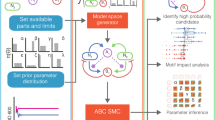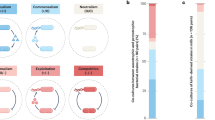Abstract
The activities of complex communities of microbes affect biogeochemical transformations in natural, managed and engineered ecosystems. Meaningfully defining what constitutes a community of interacting microbial populations is not trivial, but is important for rigorous progress in the field. Important elements of research in microbial community ecology include the analysis of functional pathways for nutrient resource and energy flows, mechanistic understanding of interactions between microbial populations and their environment, and the emergent properties of the complex community. Some emergent properties mirror those analyzed by community ecologists who study plants and animals: biological diversity, functional redundancy and system stability. However, because microbes possess mechanisms for the horizontal transfer of genetic information, the metagenome may also be considered as a community property.
Similar content being viewed by others
Log in or create a free account to read this content
Gain free access to this article, as well as selected content from this journal and more on nature.com
or
References
Allison SD . (2005). Cheaters, diffusion and nutrients constrain decomposition by microbial enzymes in spatially structured environments. Ecol Lett 8: 626–635.
Azam F, Malfatti F . (2007). Microbial structuring of marine ecosystems. Nat Rev Microbiol 5: 782–791.
Bardgett RD, Freeman C, Ostle NJ . (2008). Microbial contributions to climate change through carbon cycle feedbacks. ISME J 2: 805–814.
Behrens S, Losekann T, Pett-Ridge J, Weber PK, Ng WO, Stevenson BS et al. (2008). Linking microbial phylogeny to metabolic activity at the single-cell level by using enhanced element labeling-catalyzed reporter deposition fluorescence in situ hybridization (EL-FISH) and NanoSIMS. Appl Environ Microbiol 74: 3143–3150.
Beninca E, Huisman J, Heerkloss R, Johnk KD, Branco P, Van Nes EH et al. (2008). Chaos in a long-term experiment with a plankton community. Nature 451: 822–825.
Bertin C, Yang XH, Weston LA . (2003). The role of root exudates and allelochemicals in the rhizosphere. Plant Soil 256: 67–83.
Causarano HJ, Shaw JN, Franzluebbers AJ, Reeves DW, Raper RL, Balkcom KS et al. (2007). Simulating field-scale soil organic carbon dynamics using EPIC. Soil Sci Soc Am J 71: 1174–1185.
Clements FE . (1916). Plant Succession: An Analysis of the Development of Vegetation. Carnegie Institution: Washington, D.C.
Cooper JE . (2007). Early interactions between legumes and rhizobia: disclosing complexity in a molecular dialogue. J Appl Microbiol 103: 1355–1365.
Cravatt BF, Wright AT, Kozarich JW . (2008). Activity-based protein profiling: from enzyme chemistry. Annu Rev Biochem 77: 383–414.
Curtis TP, Head IM, Lunn M, Woodcock S, Schloss PD, Sloan WT . (2006). What is the extent of prokaryotic diversity? Philos Trans R Soc B Biol Sci 361: 2023–2037.
DeLong EF, Preston CM, Mincer T, Rich V, Hallam SJ, Frigaard NU et al. (2006). Community genomics among stratified microbial assemblages in the ocean's interior. Science 311: 496–503.
Des Marais DJ . (2003). Biogeochemistry of hypersaline microbial mats illustrates the dynamics of modern microbial ecosystems and the early evolution of the biosphere. Biol Bull 204: 160–167.
Dolfing J . (2001). The microbial logic behind the prevalence of incomplete oxidation of organic compounds by acetogenic bacteria in methanogenic environments. Microb Ecol 41: 83–89.
Ducklow H . (2007). 10th Symposium on Aquatic Microbial Ecology (SAME 10). Faro: Portugal, pp 13–19.
Ehrlich HL . (1998). Geomicrobiology: its significance for geology. Earth-Sci Rev 45: 45–60.
Fenchel T, King G.M, Blackburn H . (1998). Bacterial Biogeochemistry: The Ecophysiology of Mineral Cycling. Academic Press: San Diego.
Gillor O, Etzion A, Riley MA . (2008). The dual role of bacteriocins as anti- and probiotics. Appl Microbiol Biotechnol 81: 591–606.
Gleason HA . (1926). The Individualistic Concept of the Plant Association. Bull Torrey Botanical Club 53: 7–26.
Gonzalez JE, Keshavan ND . (2006). Messing with bacterial quorum sensing. Microbiol Molec Biol Rev 70: 859–875.
Gottschal JC . (1993). Growth-kinetics and competition—some contemporary comments. Antonie Van Leeuwenhoek Int J Gen Mol Microbiol 63: 299–313.
Huang WE, Ferguson A, Singer AC, Lawson K, Thompson IP, Kalin RM et al. (2009). Resolving genetic functions within microbial populations: in situ analyses using rRNA and mRNA stable isotope probing coupled with single-cell Raman-fluorescence in situ hybridization. Appl Environ Microbiol 75: 234–241.
Hughes VM, Datta N . (1983). Conjugative plasmids in bacteria of the pre-antibiotic era. Nature 302: 725–726.
Izaurralde RC, Williams JR, McGill WB, Rosenberg NJ, Jakas MCQ . (2006). Simulating soil C dynamics with EPIC: model description and testing against long-term data. Ecol Modell 192: 362–384.
Jessup CM, Kassen R, Forde SE, Kerr B, Buckling A, Rainey PB et al. (2004). Big questions, small worlds: microbial model systems in ecology. Trends Ecol Evol 19: 189–197.
Juhas M, van der Meer JR, Gaillard M, Harding RM, Hood DW, Crook DW . (2009). Genomic islands: tools of bacterial horizontal gene transfer and evolution. FEMS Microbiol Rev 33: 376–393.
Konopka A . (2006). Microbial ecology: searching for principles. Microbe 1: 175–179.
Levin S . (1999). Fragile Dominion: Complexity and the Commons. Basic Books: New York.
Levins R, Lewontin RC . (1985). Dialectics and reduction in ecology. In: Levins R and Richard C Lewontin (eds). The Dialectical Biologist. Harvard University Press: Cambridge, pp 132–160.
Ley RE, Harris JK, Wilcox J, Spear JR, Miller SR, Bebout BM et al. (2006). Unexpected diversity and complexity of the Guerrero Negro hypersaline microbial mat. Appl Environ Microbiol 72: 3685–3695.
Little AEF, Robinson CJ, Peterson SB, Raffa KE, Handelsman J . (2008). Rules of engagement: interspecies interactions that regulate microbial communities. Annu Rev Microbiol 62: 375–401.
Loreau M . (2000). Biodiversity and ecosystem functioning: recent theoretical advances. Oikos 91: 3–17.
Madsen EL . (2005). Identifying microorganisms responsible for ecologically significant biogeochemical processes. Nat Rev Microbiol 3: 439–446.
Magurran AE . (2004). Measuring Biological Diversity. Blackwell Science, Oxford, UK.
McDonald IR, Bodrossy L, Chen Y, Murrell JC . (2008). Molecular ecology techniques for the study of aerobic methanotrophs. Appl Environ Microbiol 74: 1305–1315.
Miethke M, Marahiel MA . (2007). Siderophore-based iron acquisition and pathogen control. Microbiol Molec Biol Rev 71: 413–451.
Miletto M, Bodelier PLE, Laanbroek HJ . (2007). Improved PCR-DGGE for high resolution diversity screening of complex sulfate-reducing prokaryotic communities in soils and sediments. J Microbiol Methods 70: 103–111.
Mills HJ, Hunter E, Humphrys M, Kerkhof L, McGuinness L, Huettel M et al. (2008). Characterization of nitrifying, denitrifying, and overall bacterial communities in permeable marine sediments of the northeastern Gulf of Mexico. Appl Environ Microbiol 74: 4440–4453.
Moran NA, McCutcheon JP, Nakabachi A . (2008). Genomics and Evolution of Heritable Bacterial Symbionts. Annu Rev Genet 42: 165–190.
Musat N, Halm H, Winterholler B, Hoppe P, Peduzzi S, Hillion F et al. (2008). A single-cell view on the ecophysiology of anaerobic phototrophic bacteria. Proc Natl Acad Sci USA 105: 17861–17866.
Naeem S . (2009). Ecology Gini in the bottle. Nature 458: 579–580.
Naeem S, Kawabata Z, Loreau M . (1998). Transcending boundaries in biodiversity research. Trends Ecol Evol 13: 134–135.
O’Donnell AG, Young IM, Rushton SP, Shirley MD, Crawford JW . (2007). Visualization, modelling and prediction in soil microbiology. Nat Rev Microbiol 5: 689–699.
O’Malley MA, Dupre J . (2007). Size doesn’t matter: towards a more inclusive philosophy of biology. Biol Philos 22: 155–191.
Overmann J, van Gemerden H . (2000). Microbial interactions involving sulfur bacteria: implications for the ecology and evolution of bacterial communities. FEMS Microbiol Rev 24: 591–599.
Picioreanu C, Kreft JU, van Loosdrecht MCM . (2004). Particle-based multidimensional multispecies biofilm model. Appl Environ Microbiol 70: 3024–3040.
Pimm SL . (1984). The complexity and stability of ecosystems. Nature 307: 321–326.
Prado F, Kerr B . (2008). The evolution of restraint in bacterial biofilms under nontransitive competition. Evolution 62: 538–548.
Prosser JI, Bohannan BJM, Curtis TP, Ellis RJ, Firestone MK, Freckleton RP et al. (2007). Essay—the role of ecological theory in microbial ecology. Nat Rev Microbiol 5: 384–392.
Reed HE, Martiny JBH . (2007). Testing the functional significance of microbial composition in natural communities. FEMS Microbiol Ecol 62: 161–170.
Reemtsma T . (2009). Determination of molecular formulas of natural organic matter molecules by (ultra-) high-resolution mass spectrometry status and needs. J Chromatogr A 1216: 3687–3701.
Reichenbach T, Mobilia M, Frey E . (2007). Mobility promotes and jeopardizes biodiversity in rock-paper-scissors games. Nature 448: 1046–1049.
Riley MA, Wertz JE . (2002). Bacteriocins: Evolution, ecology, and application. Annu Rev Microbiol 56: 117–137.
Robin A, Vansuyt G, Hinsinger P, Meyer JM, Briat JF, Lemanceau P . (2008). Iron dynamics in the rhizosphere: consequences for plant health and nutrition. Adv Agronomy 99: 183–225.
Roesch LF, Fulthorpe RR, Riva A, Casella G, Hadwin AKM, Kent AD et al. (2007). Pyrosequencing enumerates and contrasts soil microbial diversity. ISME J 1: 283–290.
Roling WFM, van Breukelen BM, Bruggeman FJ, Westerhoff HV . (2007). Ecological control analysis: being(s) in control of mass flux and metabolite concentrations in anaerobic degradation processes. Environ Microbiol 9: 500–511.
Ryan RP, Dow JM . (2008). Diffusible signals and interspecies communication in bacteria. Microbiol-SGM 154: 1845–1858.
Sogin ML, Morrison HG, Huber JA, Mark Welch D, Huse SM, Neal PR et al. (2006). Microbial diversity in the deep sea and the underexplored ‘rare biosphere’. Proc Natl Acad Sci USA 103: 12115–12120.
Sowell SM, Wilhelm LJ, Norbeck AD, Lipton MS, Nicora CD, Barofsky DF et al. (2009). Transport functions dominate the SAR11 metaproteome at low-nutrient extremes in the Sargasso Sea. ISME J 3: 93–105.
Sterelny K . (2006). Local ecological communities. Philos Sci 73: 215–231.
Suttle CA . (2007). Marine viruses—major players in the global ecosystem. Nat Rev Microbiol 5: 801–812.
Tilman D . (1999). The ecological consequences of changes in biodiversity: a search for general principles. Ecology 80: 1455–1474.
Tilman D, Reich PB, Knops JMH . (2006). Biodiversity and ecosystem stability in a decade-long grassland experiment. Nature 441: 629–632.
Tringe SG, Hugenholtz P . (2008). A renaissance for the pioneering 16S rRNA gene. Curr Opin Microbiol 11: 442–446.
Villarreal DT, Turco RF, Konopka A . (1991). Propachlor degradation by a soil bacterial community. Appl Environ Microbiol 57: 2135–2140.
Wakeham SG, Amann R, Freeman KH, Hopmans EC, Jorgensen BB, Putnam IF et al. (2007). Microbial ecology of the stratified water column of the Black Sea as revealed by a comprehensive biomarker study. Org Geochem 38: 2070–2097.
Walker JJ, Pace NR . (2007). Endolithic microbial ecosystems. Annu Rev Microbiol 61: 331–347.
Wanner G, Vogl K, Overmann J . (2008). Ultrastructural characterization of the prokaryotic symbiosis in ‘Chlorochromatium aggregatum’. J Bacteriol 190: 3721–3730.
Wertz S, Degrange V, Prosser JI, Poly F, Commeaux C, Freitag T et al. (2006). Maintenance of soil functioning following erosion of microbial diversity. Environ Microbiol 8: 2162–2169.
Wittebolle L, Marzorati M, Clement L, Balloi A, Daffonchio D, Heylen K et al (2009). Initial community evenness favours functionality under selective stress. Nature 458: 623–626.
Young IM, Crawford JW, Nunan N, Otten W, Spiers A . (2008). Microbial distribution in soils: physics and scaling. Adv Agronomy 100: 81–121.
Acknowledgements
This work was conducted in part under the Laboratory Directed Research and Development Program at Pacific Northwest National Laboratory, a multiprogram national laboratory operated by Battelle for the U.S. Department of Energy under Contract DE-AC05-76RL01830.
Author information
Authors and Affiliations
Corresponding author
Rights and permissions
About this article
Cite this article
Konopka, A. What is microbial community ecology?. ISME J 3, 1223–1230 (2009). https://doi.org/10.1038/ismej.2009.88
Published:
Issue date:
DOI: https://doi.org/10.1038/ismej.2009.88
Keywords
This article is cited by
-
VESPA: an optimized protocol for accurate metabarcoding-based characterization of vertebrate eukaryotic endosymbiont and parasite assemblages
Nature Communications (2024)
-
Uncovering the microbiome landscape in sashimi delicacies
Scientific Reports (2024)
-
The Microbiome Function in a Host Organism: A Medical Puzzle or an Essential Ecological Environment?
Biological Theory (2024)
-
High-energy diet modify rumen microbial composition and microbial energy metabolism pattern in fattening sheep
BMC Veterinary Research (2023)
-
Pedogenesis of typical zonal soil drives belowground bacterial communities of arable land in the Northeast China Plain
Scientific Reports (2023)



